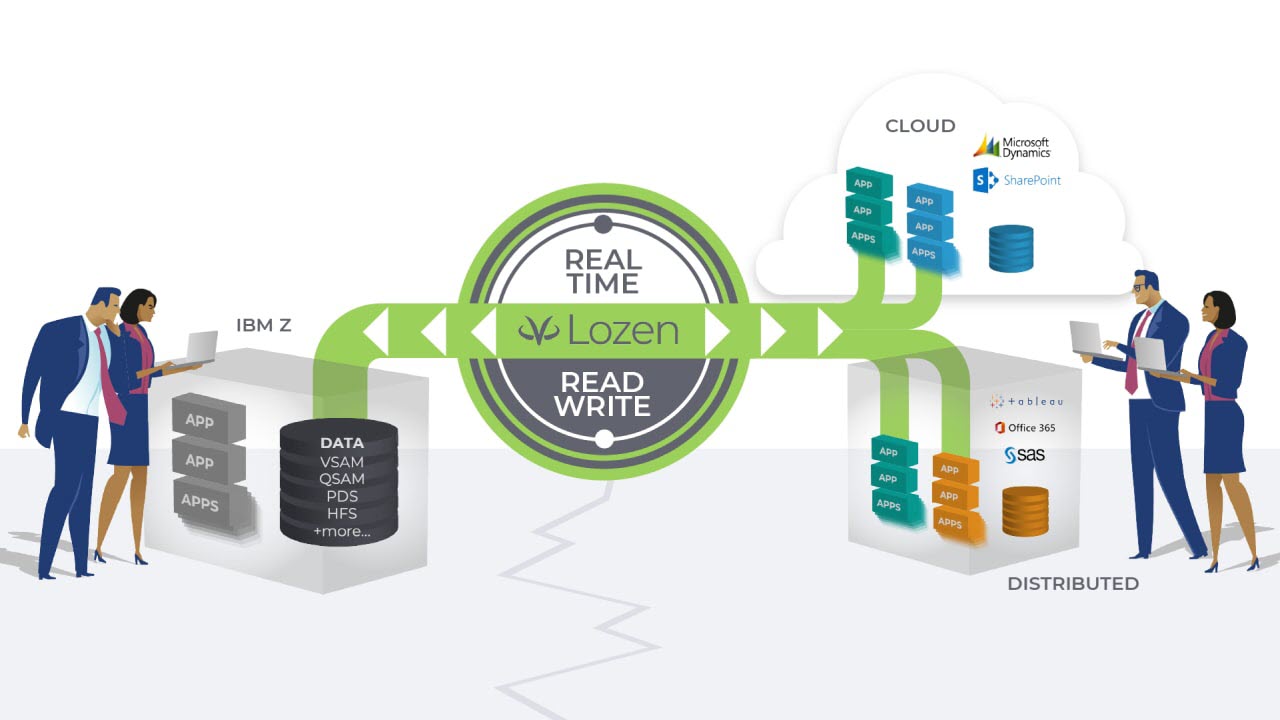 CLOUD
CLOUD
 CLOUD
CLOUD
 CLOUD
CLOUD
A team of mainframe computing veterans today is launching a set of products for streamlining access to big iron data and announcing $2.2 million in seed financing.
VirtualZ Computing Corp. is addressing the difficulty organizations have integrating data from IBM Corp. mainframes into their cloud applications. Mainframe data is often in older, proprietary formats that are not readily compatible with modern cloud-based systems. Securely and efficiently transferring data from a mainframe to cloud services can also be hindered by network bandwidth limitations and connectivity issues, especially if the mainframe is not designed to interact frequently with external systems.
As a result, organizations typically migrate data in batch processes overnight to avoid disrupting operations. That time-consuming process can consume up to 40% of the mainframe’s capacity. Reformatting and loading that data into another store, a process called extract/transform/load, also takes time.
The business implications of those delays are that cloud applications often must rely on copies of production data that are a couple of days old.
“If you need to change your address on an insurance policy you often don’t see it reflected on your records for 24 to 48 hours,” said Jeanne Glass, VirtualZ’s founder and chief executive. “Often, that’s because they lift and shift that data overnight. Sometimes that batch job fails, so you don’t get fresh data for another two days. So your insurance company is making quotes on policies based on two-day-old data.”
VirtualZ says enterprises spend millions of dollars writing custom code to extract, transform and replicate data copies from mainframes to hybrid cloud or distributed storage. In addition to the time required, those processes create data duplication, version control headaches and synchronization problems. “It’s a change data capture problem and there’s no easy solution,” said VirtualZ Executive Chairman Marc Sokol.
Despite their age (the IBM 360 architecture turns 60 next April) mainframes still process critical transactions at two-thirds of Fortune 100 companies, 45 of the world’s top 50 banks, eight of the top 10 insurers, four of the top five airlines, and eight of the top 10 retailers, according to IBM.
VirtualZ’s Lozen software enables hybrid cloud, software-as-a-service, distributed and custom applications to get real-time, read-write access to mainframe data without copying or moving it. It doesn’t rely on workarounds like terminal emulation but connects directly to mainframe data stores at the application level.
All applications share the data equally as a peer with mainframe applications. The company said Lozen can be installed in minutes and uses the System z Integrated Information Processor, a specialty processor that runs workloads outside of the mainframe CPU to improve performance and reduce costs since zIIP isn’t subject to software licensing fees.
“Our products eliminate all that code development and lifting and shifting of data across the network by providing real-time access to the data,” said Glass, who holds the distinction of being the first female founder of a mainframe company. “Applications on the mainframe, in the cloud and on distributed platforms all share the single source of truth in real-time.”
The company’s second product, called Zaac, is essential Lozen in reverse. It gives mainframe applications real-time read-write access to external data in hybrid clouds, external physical storage and SaaS applications. A third product, PropelZ, enables a one-time copy of mainframe data to be created for use cases that don’t require real-time or read-write access.
All of the company’s products eliminate the need for batch ETL procedures by transforming data on the fly. “We can read the Cobol copy book, understand all the data structures and do all the transformations,” Sokol said. “It transforms data from the mainframe to the cloud and when writing it the other way.” IBM has said up to 20% of mainframe processing cycles are typically spent on ETL.

Vince Re was the principal developer of the widely used Top Secret mainframe security software.
The products’ transformer software is capable of converting the Extended Binary Coded Decimal Interchange Code used by IBM mainframe and midrange computer systems into the widely used ASCII and other formats. Connectors are also available for Micro Focus International plc’s Enterprise Server, MuleSoft Inc.’s Anypoint Studio development environment and any integration platform that supports the OpenAPI specification. Built-in network file system protocols allow mainframe data to be stored as local files on any NFS-compatible file system, including Amazon Web Services Inc.’s low-cost S3 file storage.
“You can take a Cobol application on the mainframe and move it to the cloud using a product like Micro Focus and run that application accessing mainframe data,” Sokol said, “or you can have a new application in the cloud that writes to a VSAM file. This is all done in a straightforward way with no special permissions at the application level.” Virtual Storage Access Method is a file storage format used in IBM’s mainframes for high-speed data access applications.
VirtualZ’s products are the brainchild of co-founder and Chief Technology Officer Vince Re (adjacent), a 30-year veteran of CA Technologies Inc. and that company’s first distinguished engineer. Re hosts numerous videos on the company’s website with deep technical explanations of how the products work.
For a company that has yet to book any customer revenue, VirtualZ has lined up an impressive roster of partners. Microsoft Corp. is a development partner and lists Lozen and PropelZ in its Azure Marketplace. IBM plans to add VirtualZ’s products to its mainframe and cloud marketplaces and both Accenture plc and Infosys Ltd. are reference partners. VirtualZ has raised a total of $4.9 million and has “more committed as soon as we have our first signed contracts,” Glass said.
The company’s products may cause sticker shock for some — Lozen and Zaac are priced at $150,000 for the first terabyte of data and PropelZ carries a flat annual fee of $50,000 – but such license fees are typical of the mainframe world.
Support our open free content by sharing and engaging with our content and community.
Where Technology Leaders Connect, Share Intelligence & Create Opportunities
SiliconANGLE Media is a recognized leader in digital media innovation serving innovative audiences and brands, bringing together cutting-edge technology, influential content, strategic insights and real-time audience engagement. As the parent company of SiliconANGLE, theCUBE Network, theCUBE Research, CUBE365, theCUBE AI and theCUBE SuperStudios — such as those established in Silicon Valley and the New York Stock Exchange (NYSE) — SiliconANGLE Media operates at the intersection of media, technology, and AI. .
Founded by tech visionaries John Furrier and Dave Vellante, SiliconANGLE Media has built a powerful ecosystem of industry-leading digital media brands, with a reach of 15+ million elite tech professionals. The company’s new, proprietary theCUBE AI Video cloud is breaking ground in audience interaction, leveraging theCUBEai.com neural network to help technology companies make data-driven decisions and stay at the forefront of industry conversations.